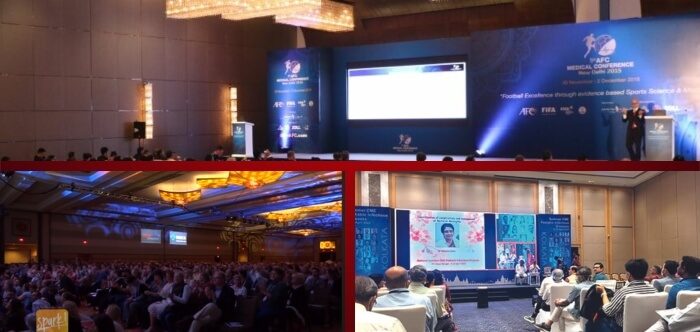The art of advertising in today’s digital age has transformed immensely. When it comes to niche sectors like the medical field, tailored strategies become essential to reach the desired audience. So, how do you advertise at a medical conference?
One effective approach is by leveraging online platforms such as Google Ads, social media advertising, and medical-centric websites. By focusing on these avenues and employing demographic targeting, organizers can ensure their promotions reach the professionals and enthusiasts most keen on attending.
As we delve deeper into this blog, we’ll explore the nuances of these advertising methods, ensuring you get the most out of your marketing efforts for your medical conference.
What Does a Medical Conference stand for?
A medical conference typically brings together a diverse group of healthcare professionals. They discuss recent research, innovative techniques, and collaborative opportunities. Networking is also a significant component, enabling attendees to forge valuable connections and collaborations.

Beyond just the exchange of scientific knowledge, these conferences often feature exhibitions. Here, companies showcase their latest products, tools, and technologies tailored for the medical field. For many professionals, attending such conferences becomes a blend of educational enrichment and an opportunity to explore state-of-the-art tools.
It is also common for an international medical management conference to set the tone for upcoming trends and practices in medicine in the upcoming years. Keynote addresses, panel discussions, and breakout sessions give attendees a comprehensive understanding of the direction the medical world is headed, making sure they stay on top.
What Makes the Medical Conference Important?
Medical conferences have cemented their importance in the healthcare arena. They’re more than mere gatherings; they’re hubs of innovation, learning, and networking for professionals worldwide.
Platform for Knowledge Exchange
Medical conferences serve as epicenters for knowledge dissemination. Professionals present research findings, ensuring rapid information spread. This facilitates better patient care and medical progress.
Networking Opportunities
Building connections in medicine is invaluable for collaboration. Conferences provide the perfect environment for such interactions. These relationships often lead to joint research or treatment endeavors.
Exposure to Latest Technologies
Innovative tools and techniques are regularly showcased at these events. Attendees get firsthand experience with cutting-edge equipment. Such exposure can significantly enhance clinical practice.
Setting Industry Standards
Conferences often help in setting benchmarks in healthcare. Leading experts discuss and finalize best practice guidelines. These standards influence global medical practices, ensuring consistency and quality.
Continuing Medical Education

Medical conferences are more than just events; they are the lifeblood of the evolving medical field. Through them, the global healthcare community ensures that patient care remains top-notch and professionals are consistently updated with the latest in the industry.
How Do You Advertise at a Medical Conference?
Successfully advertising at a medical conference requires a blend of traditional and digital strategies. It’s about positioning, audience understanding, and effective messaging to capture the right attention.
Step-1. Understand Your Target Audience
Begin by analyzing your desired attendees. Understand their needs, interests, and professional backgrounds. This analysis will guide your advertising content and channel selection.
Step-2. Design Attention-Grabbing Materials
Craft banners, brochures, and digital ads that resonate with health professionals. Emphasize the unique selling points of your conference. Ensure a cohesive visual and informational theme across all materials.
Step-3. Utilize Digital Platforms
Harness the power of online advertising tools like Google Ads. Also, promote on social media platforms frequented by medical professionals. Tailored ads can significantly boost registration numbers.
Step-4. Collaborate With Industry Websites
Partner with medical websites or forums to place your ads. These platforms already have your target audience engaged. This placement ensures your conference gets relevant visibility.
Step-5. Offer Early Bird Discounts or Packages
Incentivize registrations with early bird offers or group packages. Discounts can drive quick decisions, ensuring a steady flow of attendees well before the conference date.
Step-6. Engage in Email Marketing
Send out informative and persuasive emails to potential attendees. Highlight keynote speakers of the conference, workshops, and other attractions. A well-timed email campaign can significantly amplify attendance.
Step-7. Leverage Networking
Word-of-mouth remains powerful in the medical community. Engage past attendees, influencers, or industry leaders to spread the word. Their endorsements can lend significant credibility.
Advertising for a medical conference is a blend of understanding your audience and leveraging the right channels effectively. By following the above steps and adapting based on feedback, you can ensure a successful promotional campaign and a well-attended conference.
Common Mistakes to Avoid While Advertising
Navigating the world of advertising can be challenging, with pitfalls awaiting the unprepared. Avoiding common mistakes is crucial for a successful campaign.
- Neglecting Target Audience Research: Understanding your audience is fundamental. Misreading them can lead to ineffective ad placements and messaging.
- Overloading with Information: Simplicity often trumps complexity. Bombarding potential customers with too much information can deter rather than attract them.
- Ignoring Feedback: Listening to audience feedback refines campaigns. Ignoring it risks repeating ineffective strategies.
- Setting Vague Goals: Clear, measurable objectives guide advertising efforts. Ambiguous goals lead to scattered, unproductive strategies.
- Underestimating Budget Needs: Effective advertising often requires investment. Skimping on a budget can result in subpar ad quality or reach.
- Overlooking Digital Platforms: In today’s age, digital is vital. Failing to utilize online platforms can significantly limit outreach.
- Frequent Ad Changes: Consistency builds brand recognition. Constantly changing ads can confuse potential customers and dilute branding efforts.
While the world of advertising offers vast potential, it’s also rife with pitfalls. By recognizing and avoiding these common mistakes, businesses can craft more effective, resonant campaigns.
Perks of Advertising at a Medical Conference
Advertising at a medical conference is a strategic move, positioning businesses at the heart of industry developments and discussions. The rewards of such engagement are numerous, offering unique advantages to advertisers.
Direct Engagement with Professionals
Medical conferences are a nexus of industry experts, practitioners, and budding professionals. By advertising at such an event, companies have the golden opportunity to engage directly with these attendees. This face-to-face interaction offers immediate feedback, opens doors to potential collaborations, and allows businesses to gauge real-time reactions to their products or services.
Brand Visibility and Recognition
A conference, with its concentrated audience, offers unparalleled brand exposure. When a business advertises at such a platform, it not only boosts brand visibility but also aligns its reputation with the esteemed nature of the event. Over time, this association with significant conferences enhances credibility and fosters trust among industry professionals.
Introduction of New Products
Launching a product at a conference is strategic. Given that attendees are always on the lookout for the latest innovations and tools, it’s the perfect venue to introduce something new. By doing so, companies can ensure immediate exposure to a relevant audience, gather initial feedback, and, in many cases, see a quicker adoption rate in the industry.
Real-time Networking Opportunities
While advertisements play their part, the human connection cannot be understated. Conferences allow businesses to network in person, facilitating discussions that might lead to future collaborations, partnerships, or business opportunities. These genuine, in-person interactions often lay the foundation for long-lasting professional relationships.
Gain Competitive Insight
Advertising at a conference isn’t a one-way street. While companies promote their offerings, they’re also in a prime position to observe competitors. This observational advantage gives businesses a clearer understanding of market dynamics, competitor strategies, and emerging industry trends, which can be invaluable for future planning.
In summation, advertising at a medical conference isn’t just about promoting a brand or product. It’s about immersing oneself in the industry’s heartbeat, understanding its rhythms, forging genuine connections, and ensuring that as the medical field evolves, your brand evolves with it.
Bottom Lines
In the rapidly evolving realm of healthcare, understanding how to position oneself effectively is paramount. The answer to “How do you advertise at a medical conference?” is multi-faceted, blending both digital strategies with traditional methods.
As these conferences serve as hubs of knowledge dissemination, networking, and innovation, the advertising stakes are notably high. By harnessing platforms like Google Ads and industry-centric sites, coupled with direct engagement and keen audience insights, one can significantly enhance their brand visibility.
In essence, advertising at such events isn’t merely about brand promotion but about aligning with the industry’s pulse, ensuring relevancy and resonance in a constantly evolving field.






